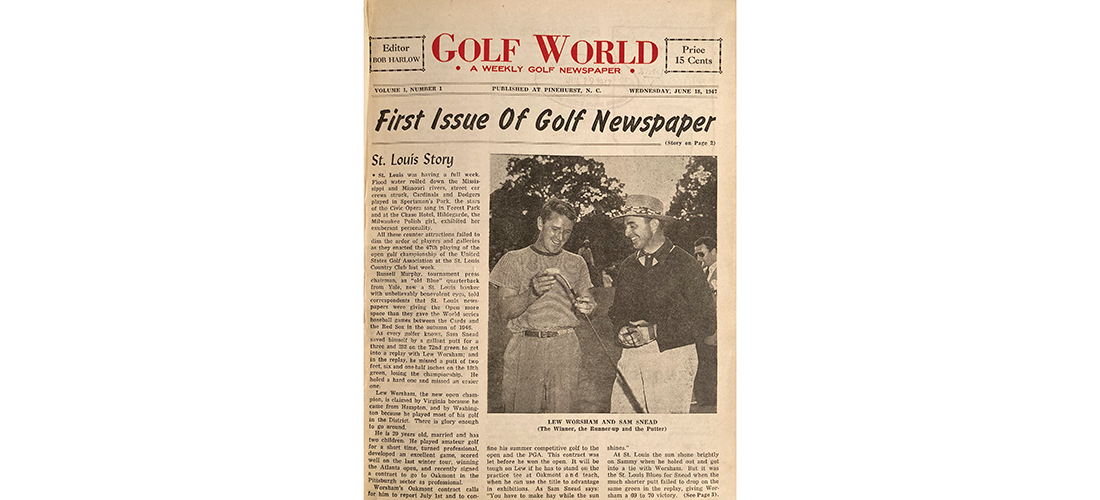
Golf’s Front Porch
The little magazine that could
By Bill Fields
Seventy-five years ago this month, Pinehurst resident Robert Harlow gave golf something, a present that provided pleasure for decades. His creation was Golf World, a weekly publication that would become an important square in the quilt of the game.
Remembering Golf World is personal for me because the magazine was my professional home for nearly a quarter-century.
I wasn’t around for the debut edition — June 18, 1947, which covered Lew Worsham’s U.S. Open victory over Sam Snead — but in two stints I worked in various capacities on more than 800 Golf World issues and was a senior editor when subscribers received their last print copy eight years ago. Current PineStraw editor Jim Moriarty, who like me had a long history with Golf World, wrote the final cover story on Rory McIlroy winning the Open Championship at Royal Liverpool (where, coincidentally, Fred Daly took the Claret Jug during Golf World’s first year).
A couple of days after we put that print edition to bed on a Monday night, positions were eliminated and so was a meaningful chapter of golf history. Those of us who worked there lamented the loss. So did thousands of Golf World readers, many of them avid players or part of the industry, for whom the publication was a pillar in their golf lives.
Harlow called his creation a newspaper when it launched, but soon enough it was seen as a magazine. By any name the publication was golf’s front porch and party line, where people found out what was going on in the game they loved. E. Harvie Ward Jr. of Tarboro was a subscriber. So was a young bank teller and budding golfer in New Zealand, Bob Charles, who discovered the world he one day would join despite the news being weeks late when he received his copy.
You could find Pete Dye in the results of elite amateur events and in tiny advertisements for his services as a golf architect. Philadelphia restaurateur Helen Sigel plugged her establishment and clubmaker Bert Dargie his 7-woods in the one-inch ads. Golf World also got local businesses to advertise, with The Dunes Club promoting “floor shows, excellent cuisine and dancing.” (It couldn’t come out and say it was a little Las Vegas in the longleaf.)
Golf World started small — Harlow, instrumental in the nascent days of the professional circuit in the United States, and his wife, Lillian, formed the early core — and never got very large. Over its first four decades, when it was located in Pinehurst and later Southern Pines, a skeleton staff put out the stories and the scores with help from a network of correspondents around the globe, scribes who made less for their contributions than the pros who tied for 37th in the tournaments they were covering.
Reporters doubled as photographers, and a few of us got competent with a camera. But our skills weren’t always evident, sabotaged as they were by limitations in color separations and printing that could make images appear as murky as Drowning Creek.
Before Golf World got big-time owners — The New York Times Company and later Condé Nast — it didn’t do much live photography. This meant that when someone won in Dallas in the spring, the shot of the victor on the cover was most likely taken a couple of months earlier on a tee with good light and a clean background in Los Angeles. The use of stock pictures was largely harmless, with one notable exception. When T.C. Chen won at Riviera Country Club in 1987, the photograph used on Golf World’s cover was of his older brother, T.M., taken the previous year at the Masters’ par-3 contest.
Given that I took that Kodachrome of T.M. Chen — correctly identified on the slide mount, by the way — I thought of the publishing blunder when the curtain was closed on Golf World in 2014. It made me laugh when I felt like crying. I also considered how much the magazine got right over nearly seven decades and how many readers renewed their subscriptions year after year, grateful that Bob Harlow’s idea was in the mail, with news of the game, of their game. PS
Southern Pines native Bill Fields, who writes about golf and other things, moved north in 1986 but hasn’t lost his accent.





